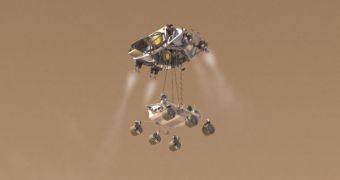Experts at the American space agency announce that they have decided on a data for the launch of their newest Martian rover. Dubbed that Mars Express Laboratory (MSL), or Curiosity, the instrument will be about the size of a small car, and will weigh more than a ton. It will employ a revolutionary landing system, and will rock technologies that have never been deployed to space before. The machine will be powered by a nuclear engine, and will be able to endure even in conditions that would incapacitate rovers that rely on solar panels for electricity. At this point, the MSL is scheduled for launch in a window stretching between November 25 and December 18, 2011, mission planners say.
If engineers manage to stick to this plan, then the rover will arrive at Mars between August 6 and 20, 2012. Due to a fortuitous alignment of the planets, the landing will take place under the best conditions, contact-wise. Communications intensity and the geometry of the Mars-Earth system at the time of landing were the main factors that informed the selection of the launch and landing dates, say NASA experts at the Jet Propulsion Laboratory (JPL), in Pasadena, California. The team here will manage the MSL mission for the space agency's Science Mission Directorate, at NASA Headquarters in Washington DC.
The current plan will allow mission manager to obtain the maximum amount of information possible during atmospheric descent and landing. “The key factor was a choice between different strategies for sending communications during the critical moments before and during touchdown. The shorter trajectory is optimal for keeping both orbiters in view of Curiosity all the way to touchdown on the surface of Mars. The longer trajectory allows direct communication to Earth all the way to touchdown,” explains NASA JPL mission manager Michael Watkins. Other than direct contact, experts could have opted to have Curiosity's signals routed through either the Mars Odyssey, or the Mars Reconnaissance Orbiter (MRO).
“It is important to capture high-quality telemetry to allow us to learn what happens during the entry, descent and landing, which is arguably the most challenging part of the mission. The trajectory we have selected maximizes the amount of information we will learn to mitigate any problems,” adds JPL Mars Exploration Program manager Fuk Li. Though the launch time has been sent, a landing site has yet to be selected. Four candidate regions are currently being considered. All of them made the final selection, which took place in November 2008, but scientists have yet to decide on which is the safest, and most scientifically-valuable.

 14 DAY TRIAL //
14 DAY TRIAL //